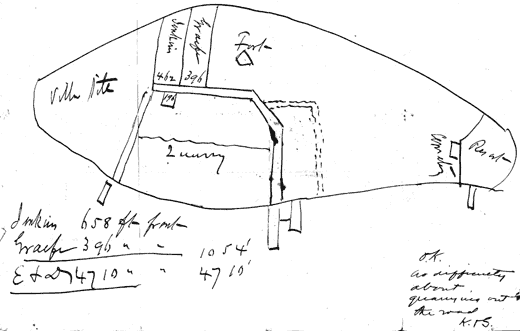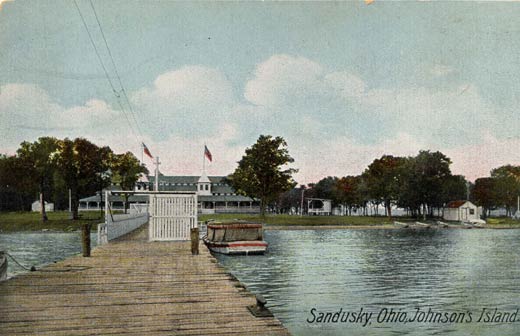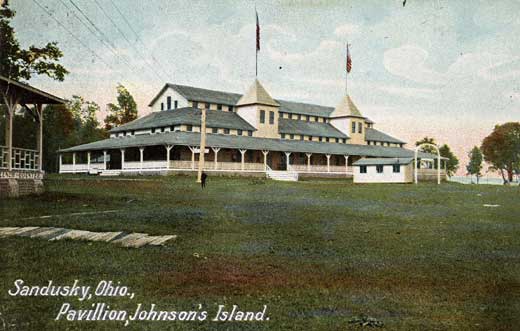Island History
Pleasure Resort Era

The pleasure resorts on Johnson’s Island created an air of fun, gaiety and enjoyment not seen before or after the Pleasure Resort Era. Forgotten were the harsh memories of the Prisoner of War Depot. Unfortunately, the resorts did not last very long – a cumulative total of eight years. The first Johnson’s Island Pleasure Resort Company leased about twenty acres of land in 1894. The resort was in business from July of 1894 to September of 1897, when operations were discontinued. In 1904, a new group purchased the stock and lease rights of the resort and retained its name. The resort was then operated for four years until it, too, was sold to a different owner, the Cedar Point Pleasure Resort Company.
On December 18, 1894, Leonard S. Johnson leased the area of Johnson’s Island, north of the Confederate Cemetery, which amounted to twenty acres. The north fence line of the cemetery was the start of the boundary line. The rough location is shown on the map below. The lease also included a thirty foot wide right of way from the resort to the east fort (Fort Johnson) including the fort itself.
The lease was for three years with an option for another ten years, if desired by the resort owners. Three incorporators of the Johnson’s Island Pleasure Resort, John Waterfield, John L. Rieger, and J. M. Schumaker signed the lease. On the same day, the parties also executed a mortgage deed for the same property for the consideration of $4,140 which was paid to Johnson for a promissory note from him. The resort actually opened on July 3, 1894, prior to executing the above formal lease.

Apparently the resort owners recognized the need for a more organized and formal company to run the resort especially since they were seeking to raise funds by the sale of stock. Hence, the resort company was incorporated in March of 1895, after the first season had ended.
Initially, in order to get the fledgling resort opened and ready to compete with Cedar Point, many of the buildings, including the main pavilion, were mere canvas- covered structures, which were less expensive and quicker to erect. Despite opening after one-third of the tourist season was over, there were enough visitors to warrant regularly scheduled boat service between Sandusky and the island. Johnson’s Island had the advantage of being reached after a short boat ride that could be made comfortably in most of the summer weather.
The island had historical significance as it was a Prisoner of War Depot during The War Between The States. Walking paths led to areas where visitors could enjoy a picnic lunch near what remained of the Union Officers Quarters and the two Civil War forts. Much of the resort area was wooded, offering shade from the hot summer sun.
Along with the many families that visited the resort were the members of several organizations that came as groups. The Presbyterian Sunday school held its annual picnic at the resort on July 20, 1894. It was well attended by large numbers of teachers, children and friends. Some stayed late for the moonlight ride back to Sandusky. In August, the (Sandusky) Register Correspondents Association chartered the steamer A. W. Burch for its annual meeting and picnic. Their first stop was a combined tour of the old prison site and the resort on Johnson’s Island.
Perhaps one of the more interesting groups to visit the resort was the Central Insane Hospital of Columbus, Ohio that came by train. Eight coaches brought 650 patients and sixty attendants to Sandusky where they embarked on a large steamer, the Wellington R. Burt, for Johnson’s Island.

The celebration of Emancipation Day was held at the resort on August 10, 1894. The Oberlin Glee Club was engaged to sing several selections for this event. It was anticipated that many people would attend the celebration. Large excursions were run over the electric road (Interurban cars) from Norwalk and Milan to Sandusky.
In its advertisements, the resort promoted Johnson’s Island as a place where “All beauties of nature and the comforts of home” could be enjoyed by families and their children. There was music and dancing on Tuesday, Thursday, and Saturday evenings. The Peoples Orchestra presented concerts on Sunday afternoons and evenings. Other attractions were the “human pretzel, Mons. Victor”, and “Colored vocalists Thomas and Euna Davis”. In 1896, an ad for the opening of the resort touted acts such as Saharet the Great Contortion Dancer, the “Walton Brothers, great acrobats”, and music by the Great Western Band and Orchestra. According to the ad, the steamers Hayes and Burt were to make one-half hour trips to the island to provide ferry service.

Eventually, a large wood frame pavilion, which included a dance floor and rooms for overnight guests, replaced the canvas tent structures. The small concession stand was replaced by a sizeable restaurant. By 1896, lighting and electric power were furnished by a generator on the island. The resort hired a manager, Albert J. Nusly, who appeared to be moving the resort in the right direction. Crowds of three to five thousand visitors were not uncommon, and the resort began to seriously compete with Cedar Point in 1897.Just as everything seemed to be going right for the pleasure resort, disaster struck in the form of a terrible accident involving a visitor, Fredrick C. Linden. On Sunday, August 8, 1897, a performance featuring a trapeze suspended from two air balloons went awry. The two balloons were released, and the first balloon ascended according to plan, but the other balloon did not because trailing lines were caught in a tree. Consequently, the trapeze artist, Miss Millie Sheets was placed in a precarious position. A gun was fired by Professor Arthur Ledyard to signal Miss Sheets to release her parachute, thereby returning her to the ground. Unfortunately for the victim, the gun was loaded with live ammunition and Ledyard fired into the crowd instead of the sky. Linder suffered a fatal wound and died on the island. Later that year, Linder’s widow brought a lawsuit against The Johnson’s Island Pleasure Resort in the amount of $10,000 for damages.
To make matters worse, a fire of unknown origin destroyed the main pavilion in December, 1897. Residents of Sandusky had to helplessly watch the building burn because they had no way to reach the island due to the early winter ice on Sandusky Bay.
The tragic accident, the fire, and the inability to turn a profit led to the demise of the first pleasure resort at the end of 1897. Apparently this was not a surprise since as early as April 1896, rumors had been spreading that the pleasure resort was going to be taken over by Cedar Point and combined with its operation.

In June of 1899, most of Johnson’s Island, owned by the estate of Leonard B. Johnson, was sold at a sheriff’s sale to James H. Emrich and Charles Dick, both of Sandusky. The land where the resort was located apparently did not change hands until May 7, 1902 at another sheriff’s sale in Ottawa County. This property was also transferred to Emmrich and Dick as they were the only bidder.
In March of 1904, the Sandusky Register reported that The Johnson’s Island Pleasure Resort would be re-opened that year for the summer season. Emerich and Dick leased the resort site to Captain C.L. Goodsite and Captain Andrew Geisendorfer of Sandusky, who were steamboat operators. Plans were to erect a new pavilion building over the site of the remains of the one that was destroyed by fire in 1897. Also, a new bathhouse and boathouse would be built along with the modernization of the existing buildings. The estimated cost of the work was $50,000. Speculation was that a local beer company would furnish much of the money.

True to their word, the Johnson’s Island Pleasure resort was opened on May 28, 1904. A new, larger pavilion featured a large dance hall on the first floor and sleeping rooms on the second floor.
Many new attractions greeted those who arrived on one of the regularly scheduled steamboats from Sandusky. Visitors could roller skate, rent naphtha gas launches and small sailboats, see vaudeville shows, and stay in rented cottages. The resort still retained its desire to have families visit the resort. Baseball games between well known local teams drew as many as 3,000 people on a Saturday afternoon.
During the four-year period that the second resort was open, a number of new attractions were added. There was a midway, often referred to as the “Little Coney Island”. In 1906, a carousel, shooting gallery and Ferris wheel were added. A separate building was erected for the showing of the new marvel “Moving Pictures” that featured such great films as the “San Francisco Disaster.” The popular Ackley’s Band directed by Eugene B. Ackley initially gave weekend concerts but started playing weekday evenings because he was so well received.
The second resort kept alive the booking of several groups and organizations. Among those visiting the island were several regiments of the Knights of Pythias, The Sandusky Saengerbund, which performed several choral selections, the Sixth Regiment of the Ohio National Guard, and the Happy Home Hunting and Fishing Club. In 1905, Manager Goodsite started Childrens Day where children were admitted to the resort free of charge.
Visitors to Johnson’s Island came primarily from Sandusky by large steamboats. However in 1906, many people came by boat from Marblehead, Ohio. The Toledo, Lakeside, and Port Clinton Electric railway ran cars to a dock on the south shore of Marblehead (now known as Bay Point). At that point, passengers were transferred to ferry boats to make the short trip to Johnson’s Island. According to the Sandusky Register, traffic was so good that the officials of the railway assured the managers of the resort that a trestle would be built from Marblehead to the island. This was never done.
Once again, to the general public, it seemed that everything was going great for The Johnson’s Island Pleasure Resort. Unfortunately this was not what was really happening. An ominous cloud hung over the resort in the shape of Cedar Point. In December 1897, Cedar Point was sold to the Cedar Point Pleasure Resort Company of Indiana. George A. Boeckling was named President and General Manager, and, in a relatively short time he turned Cedar Point into a very successful operation. Competition from Cedar Point and other resorts and amusement parks would be too great to overcome. More capital was needed than was available to make the improvements and new rides and attractions needed to stay ahead of the competition. Also, the seven-year period from 1897 to 1904, when the Johnson’s Island Pleasure Resort was not operating, gave a great competitive edge to the Cedar Point that was never overcome.
As a result, a Memorandum of Agreement was made between the Cedar Point Pleasure Resort Company and Messrs Emrich and Dick in May of 1908. In the agreement the Johnson’s Island Pleasure Resort was transferred to Cedar Point for $800 in stock. This ended forever pleasure resorts on Johnson’s Island.
